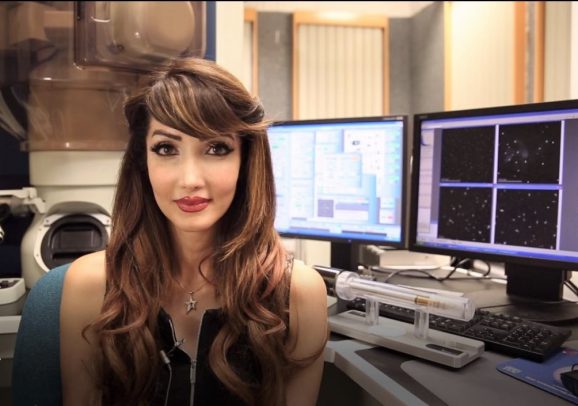Bioengineering professor looks to outsmart drug-resistant bacteria with new ‘touch and kill’ method

By David Brazy
The discoveries of penicillin and other antibiotics rightly were heralded as transformative medical innovations, but their effectiveness has been slowly undercut by the growth of antibiotic-resistant bacteria. New treatments have struggled to keep up with these drug-resistant organisms, threatening lives and worsening health outcomes across the globe.
Tolou Shokuhfar, an associate professor with the Richard and Loan Hill Department of Bioengineering at UIC, is working on a novel way to end the vicious cycle in which humans develop new drugs and bacteria evolve to beat them. Her approach involves removing the drugs altogether.
Shokuhfar explained that the antimicrobial products and drugs currently on the market all use a biochemical method to kill bacteria, which ultimately causes the bacteria to transform.
“Eventually, they impact the protein production, DNA and RNA, which means that eventually, the bacteria will have enough time to mutate and to get around those methods,” she said.
This mutation problem prompted Shokuhfar to start thinking outside of the box, looking for non-biochemical ways to destroy bacteria. Last year she received a $220,000 grant from the National Science Foundation to investigate a mechanical route using engineered nanomaterials, which she christened “touch and kill.”
The idea for this mechanical method came from nature: some insects have wings that kill bacteria that come into contact with their surface. Shokuhfar found a theoretical model of this phenomenon developed by another team of researchers in 2013. Building on this work, she used her lab’s state-of-the-art transmission electron microscope to actually see how nanopillars on the surface of the wings were destroying the bacteria.
“The stress and strain between the pillars cause the membrane of the bacteria to rupture, and it basically pops like a balloon and the bacteria dies,” Shokuhfar said. “This is a fast-acting mechanism, so it does not allow the bacteria to get smart and mutate, as the biofilm will not have time to develop.”
After witnessing the mechanical “touch and kill” in action through her electron microscope, Shokuhfar saw a great opportunity to develop new antimicrobial solutions. She recently received an award from the Chancellor’s Translational Research Initiative Program, which was created to fund UIC projects that have promising commercialization prospects but are before the proof-of-concept stage. The grant will allow Shokuhfar and her team to create nanoengineered materials that have the same pillars to puncture bacteria.
“What makes me so excited about this design is I can apply it everywhere,” Shokuhfar said. “We could put it on a myriad of devices. It could be incorporated in a hospital setting, a clinic setting, or even the home.”
For the first part of the grant, Shokuhfar plans to experiment with incorporating the nanomaterial into material to prevent infections. If her work is successful, she would then seek a partnership with a company already producing an antibacterial product to see if the nanomaterial could be incorporated into its manufacturing process.
“The good thing about engineering nanomaterials, and specifically this nanomaterial that we made, is we have the ability to incorporate it into existing materials out there in the market,” Shokuhfar said. “You can imagine how amazing this could be and how broad of an application it could have.”
Read more about Shokuhfar’s lab here: https://isnl.lab.uic.edu/isnl-dr.-tolou-shokuhfar.html
Read more about the CTRI Program here: https://otm.uic.edu/resources/ctri/
